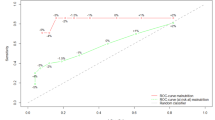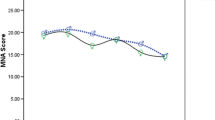Abstract
Background: Objective
The study aimed to determine the prevalence of malnutrition risk in a population of older people (aged 75 years and over) attending a community general practice and identify characteristics of those classified as malnourished or at risk of malnutrition.
Design
Cross-sectional study of nutritional risk screen conducted over a six month period.
Participants and setting
Patients attending a general practice clinic in Victoria, Australia, who attended for the “75 plus” health assessment check.
Measurements
The Mini Nutritional Assessment Short Form (MNA®-SF) was included as part of the health assessment. Information was collected on living situation, co-morbidities, independence with meal preparation and eating, number of medications. Height and weight was measured and MNA®-SF score recorded.
Results
Two hundred and twenty five patients attending a general practice for a health assessment with a mean age of 81.3(4.3)(SD) years, 52% female and 34% living alone. Only one patient was categorised by the MNA®-SF as malnourished, with an additional 16% classified as at risk of malnutrition. The mean Body Mass Index (BMI) of the at-risk group was significantly lower than the well-nourished group (23.6 ± 0.8 (SEM) vs 27.4 ± 0.3; p=0.0001). However, 34% of the at-risk group had a BMI of 25 or more with only 13% in the underweight category.
Conclusion
In this population of older adults attending their general practitioner for an annual health assessment, one in six were identified as being at nutritional risk which is an additional risk factor for a severe health issue. Importantly, one third of the at-risk group had a BMI in the overweight or obese category, highlighting that older people can be at nutritional risk although they may be overweight or obese.
Similar content being viewed by others
References
Cederholm T, Jägrén C, Hellström K. Outcome of protein-energy malnutrition in elderly medical patients. The American Journal Of Medicine 1995;98(1):67–74.
Stratton RJ, Green CJ, Elia M, editors. Disease-related malnutrition: an evidence based approach to management. Wallingford: CABI; 2003.
Feldblum I, German L, Bilenko N, Shahar A, Enten R, Greenberg D, et al. Nutritional risk and health care use before and after an acute hospitalization among the elderly. Nutrition 2009;25(4):415–420.
Vivanti AP, McDonald CK, Palmer MA, Sinnott M. Malnutrition associated with increased risk of frail mechanical falls among older people presenting to an emergency department. Emergency Medicine Australasia 2009;21(5):386–394.
Guo JJ, Yang H, Qian H, Huang L, Guo Z, Tang T. The effects of different nutritional measurements on delayed wound healing after hip fracture in the elderly. The Journal Of Surgical Research 2010;159(1):503–508.
Haydock DA, Hill GL. Impaired wound healing in surgical patients with varying degrees of malnutrition. JPEN Journal Of Parenteral And Enteral Nutrition 1986;10(6):550–554.
Kendig H, Browning C, Pedlow R, Wells Y, Thomas S. Health, social and lifestyle factors in entry to residential aged care: an Australian longitudinal analysis. Age & Ageing 2010;39(3):342–349.
Payette H, Coulombe C, Boutier V, Gray-Donald K. Nutrition risk factors for institutionalization in a free-living functionally dependent elderly population. Journal of Clinical Epidemiology 2000;53(6):579–587.
Guigoz Y. The Mini Nutritional Assessment (MNA) review of the literature-What does it tell us? The Journal Of Nutrition, Health & Aging 2006;10(6):466–485.
Rist G, Miles G, Karimi L. The presence of malnutrition in community-living older adults receiving home nursing services. Nutrition & Dietetics 2012;69(1):46–50.
National Institute for Health and Clinical Excellence. Nutrition support in adults: NICE guideline. Clinical guideline 32. London 2006.
Kondrup J, Allison SP, Elia M, Vellas B, Plauth M. ESPEN guidelines for nutrition screening 2002. Clinical Nutrition (Edinburgh, Scotland) 2003;22(4):415–421.
Raynaud-Simon A, Revel-Delhom C, Hébuterne X. Clinical practice guidelines from the French health high authority: Nutritional support strategy in protein-energy malnutrition in the elderly. Clinical Nutrition 2011;30(3):312–319.
Watterson C. Evidence based practice guidelines for the nutritional management of malnutrition in adult patients across the continuum of care. Nutrition & Dietetics 2009;66:S1–S34.
Australian and New Zealand Society of Geriatric Medicine. Under-Nutrition and the Older Person 2007. http://www.anzsgm.org/documents/PositionStatementNo6Under-NutritionintheElderry.pdf (accessed 1 July, 2012)
Newbury J, Marley J. 75+ health assessments. Australian Family Physician 2001;30(l):82–87.
Kaiser MJ, Bauer JM, Ramsch C, Uter W, Guigoz Y, Cederholm T, et al. Validation of the Mini Nutritional Assessment Short-Form (MNA®-SF): A practical tool for identification of nutritional status The Journal Of Nutrition, Health & Aging. 2009;13(9):782–788.
Green SM, Watson R. Nutritional screening and assessment tools for older adults: literature review. Journal Of Advanced Nursing 2006;54(4):477–490.
Phillips MB, Foley AL, Barnard R, Isenring EA, Miller MD. Nutritional screening in community-dwelling older adults: a systematic literature review. Asia Pacific Journal Of Clinical Nutrition 2010; 19(3):440–449.
Folstein MF, Folstein SE, McHugh PR. “Mini-mental state”. A practical method for grading the cognitive state of patients for the clinician. Journal Of Psychiatric Research 1975;12(3):189–198.
Visvanathan R, Macintosh C, Callary M, Penhall R, Horowitz M, Chapman I. The nutritional status of 250 older Australian recipients of domiciliary care services and its association with outcomes at 12 months. Journal of the American Geriatrics Society 2003;51(7):1007–1011.
Kaiser MJ, Bauer JM, Uter W, Donini LM, Stange I, Volkert D, et al. Prospective Validation of the Modified Mini Nutritional Assessment Short-Forms in the Community, Nursing Home, and Rehabilitation Setting. Journal of the American Geriatrics Society 2011;59(11):2124–2128.
Kvamme J-M, Olsen JA, Florholmen J, Jacobsen BK. Risk of malnutrition and health-related quality of life in community-living elderly men and women: the Troms0 study. Quality Of Life Research: An Internationa] Journal Of Quality Of Life Aspects Of Treatment, Care And Rehabilitation 2011;20(4):575–582 (doi 10.1007/s11136-010-9788-0).
Hébuteme X, Broussard JF, Rampai P. Acute renutrition by cyclic enteral nutrition in elderly and younger patients. JAMA: The Journal Of The American Medical Association 1995;273(8):638–643.
Hébuteme X, Schneider S, Peroux JL, Rampai P. Effects of refeeding by cyclic enteral nutrition on body composition: comparative study of elderly and younger patients. Clinical Nutrition (Edinburgh, Scotland) 1997;16(6):283–289.
Morley JE. Anorexia of aging: physiologic and pathologic. The American Journal Of Clinical Nutrition 1997;66(4):760–773.
Cabrera MAS, Mesas AE, Garcia ARL, de Andrade SM. Malnutrition and depression among community-dwelling elderly people. Journal of the American Medical Directors Association 2007;8(9):582–584.
Kvamme J-M, Grønli O, Florholmen J, Jacobsen BK. Risk of malnutrition is associated with mental health symptoms in community living elderly men and women: the Tromsø study. BMC Psychiatry 2011;11:112–.
Lee JS, Kritchevsky SB, Tylavsky F, Harris TB, Ayonayon HN, Newman AB. Factors associated with impaired appetite in well-functioning community-dwelling older adults. Journal of Nutrition for the Elderly 2006;26(1–2):27–43.
Engel JH, Siewerdt F, Jackson R, Akobundu U, Wait C, Sahyoun N. Hardiness, depression, and emotional well-being and their association with appetite in older adults. Journal of the American Geriatrics Society 2011;59(3):482–487.
Morley JE, Kraenzle D. Causes of weight loss in a community nursing home. Journal of the American Geriatrics Society 1994;42(6):583–585.
Thomas P, Hazif-Thomas C, Clement JP. Influence of antidepressant therapies on weight and appetite in the elderly. The Journal Of Nutrition, Health & Aging 2003;7(3):166–170
Author information
Authors and Affiliations
Rights and permissions
About this article
Cite this article
Winter, J., Flanagan, D., Mcnaughton, S.A. et al. Nutrition screening of older people in a community general practice, using the MNA-SF. J Nutr Health Aging 17, 322–325 (2013). https://doi.org/10.1007/s12603-013-0020-0
Received:
Accepted:
Published:
Issue Date:
DOI: https://doi.org/10.1007/s12603-013-0020-0




